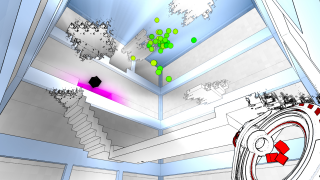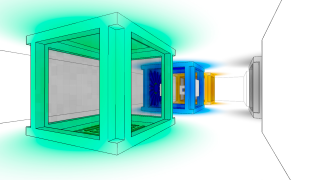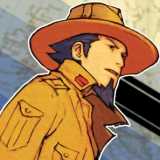Don't Look Down
By majormitch 0 Comments
I foolishly posted this on the Sunday before the new site launched. Needless to say, it got gobbled up... so here it is again!
Eatin' Skulls
I’ve been following Skulls of the Shogun’s development for quite a while (there’s been plenty of it to follow), and despite modest reviews I decided to pick it up and see for myself; I had to know. Ultimately, I think Skulls is a pretty sweet game. True to what the team at 17-Bit had been saying all along, Skulls takes a lot of cues from stuff like Advance Wars (a personal favorite of mine). It’s a turn-based strategy/tactics game that’s pretty simple on the whole, yet there’s some extra depth under the surface. It never gets quite as intricate as its inspiration, but there’s enough meat to Skulls to make it engaging and substantial enough. The handful of units are cool and all have their uses, and eating the skulls of fallen enemies to power them up is a nice touch. Eating three skulls turns a unit into a “demon” and lets them take two actions per turn, which is a literal game changer. Once you get a few demon units you feel pretty unstoppable, and figuring out how to get to that point can be exciting. Otherwise the game’s general flow and mechanics are enjoyable, and I really like the look and sound of the game. The soundtrack in particular is catchy.

While I think the core of Skulls is pretty fun, the game’s certainly not without issues. One of the weirdest things to me is the fact that you can only use five units per turn. You generally start with more than five units, and often have the option to buy more, which feels pretty pointless (unless you lose a lot of units). Basically, you have access to a larger army than you can actually use. Also, the whole “no grids” thing comes off as kind of a pandering/desperate marketing angle that doesn’t work as well in practice. Trying to select a unit among a bunched up group can be downright maddening at times. I know the average person hates the idea of grids (one of the reasons such games aren’t popular), but I think Skulls shows why grids make sense. I personally think selecting units would be much easier with a grid, and that you wouldn’t lose anything in return. Those two issues are fairly minor in the grand scheme of things, however. By far the worst thing about Skulls of the Shogun is that it’s a technical mess. I don’t know how a game in development for so long can perform so terribly, but any technical bug you can think of can probably occur in Skulls. Among other things, I experienced numerous game freezes, saving issues, and frequent frame rate drops. The worst and most bizarre issue was a dashboard level error message (I played the Xbox 360 version) that popped up and booted me out of the game for no discernible reason. I’ve never seen anything like that before, and it happened to me twice in Skulls. It’s completely baffling and inexcusable.
It’s a bummer that Skulls of the Shogun is so rife with technical problems, because a few other minor issues aside, it’s a pretty fun, lighthearted turn-based strategy/tactics game. It’s a genre that doesn’t get a lot of exposure too, and while Skulls is a somewhat “lite” entry, it’s still an enjoyable and worthwhile one. Just be prepared to put up with a lot of technical problems.
Don't Look Down
I also played through Antichamber recently, and I think that game is totally rad. When I first heard the game described using the term “non-Euclidean geometry” I was a little skeptical for a number of reasons. First, that sounds a little pretentious. Second, there’s no way to know what is actually meant by that, especially in the context of a video game. Third, would it end up being more of a tech experiment than an interesting and fun game? Fortunately, most of those fears were unfounded (it might still be a little pretentious, but that’s up to taste I suppose). I was once again reminded that it’s always good to take a “wait and see” approach with this stuff, because you just never know.

After playing Antichamber for myself, I feel like I “get” what is meant by “non-Euclidean geometry,” even if it’s a bit too abstract to describe as concisely as I’d like. The best I can do is to say that physical space doesn’t always behave as it does in the real world, and is subject to your own perception. Think about it as kind of like being inside a M.C. Escher painting. Effectively describing it gets murkier past that, because the game’s world doesn’t always seem consistent and symmetrical with its own properties. Which is maybe the point? I don’t know. What I do know is that this abstracted design allows for a whole lot of highly creative and mind-bending puzzles. Walls can shift or disappear based on how you look at them, stairways can loop around on themselves, and floors can form based on how fast you are moving. It’s completely bizarre, and equally awesome. The game demands that you think outside the box in all sorts of ways, and constantly forces you to question how things work. I think this abstract nature is a great alternative to the nuts and bolts style of most video game puzzles, and that’s the core of what makes Antichamber so cool.

I also really like the way the world is designed, and think it’s a great fit for this style of puzzle solving. At any point you can bounce back to the game’s starting room, which not only resets the puzzles and gets you out of sticky situations where you might be straight up screwed, but that room also has a map. From this map you can see how rooms connect, and also choose any room to instantly warp to, which makes getting around this crazy world convenient. The map is also pretty sprawling, and the game certainly has a substantial exploration element to it, which I really enjoyed. Whenever I got stuck on a puzzle for too long, I could go explore somewhere else, and often find another way around. There’s simply tons of varied stuff to discover, and I was consistently excited to see what was around the next corner throughout the game. It also helps that the game looks pretty striking. I like the brightly bold color palette, and they way is uses visual cues to guide a lot of your progress throughout the game is slick and smart. The game does a good job at communicating to the player without actively speaking to them. Finally, I appreciate that the game, unlike most, doesn’t feel the need to shoehorn a “story” in there. Antichamber focuses purely on doing what it does best, and I think it’s all the better for it. Not every game has to be all things to all people.
If you couldn’t tell, I really like Antichamber. That said, it’s not a perfect game either. One of the abilities you gain is wholly unintuitive, and unless I missed something it’s never so much as hinted at. I also think some of the late game cube manipulation puzzles get really tedious and aren’t that interesting. But by and large, I think Antichamber is pretty incredible. It has an ambitious and unique take on both puzzle and world design, and manages to execute it all with a high level of craft from start to finish.

0 Comments